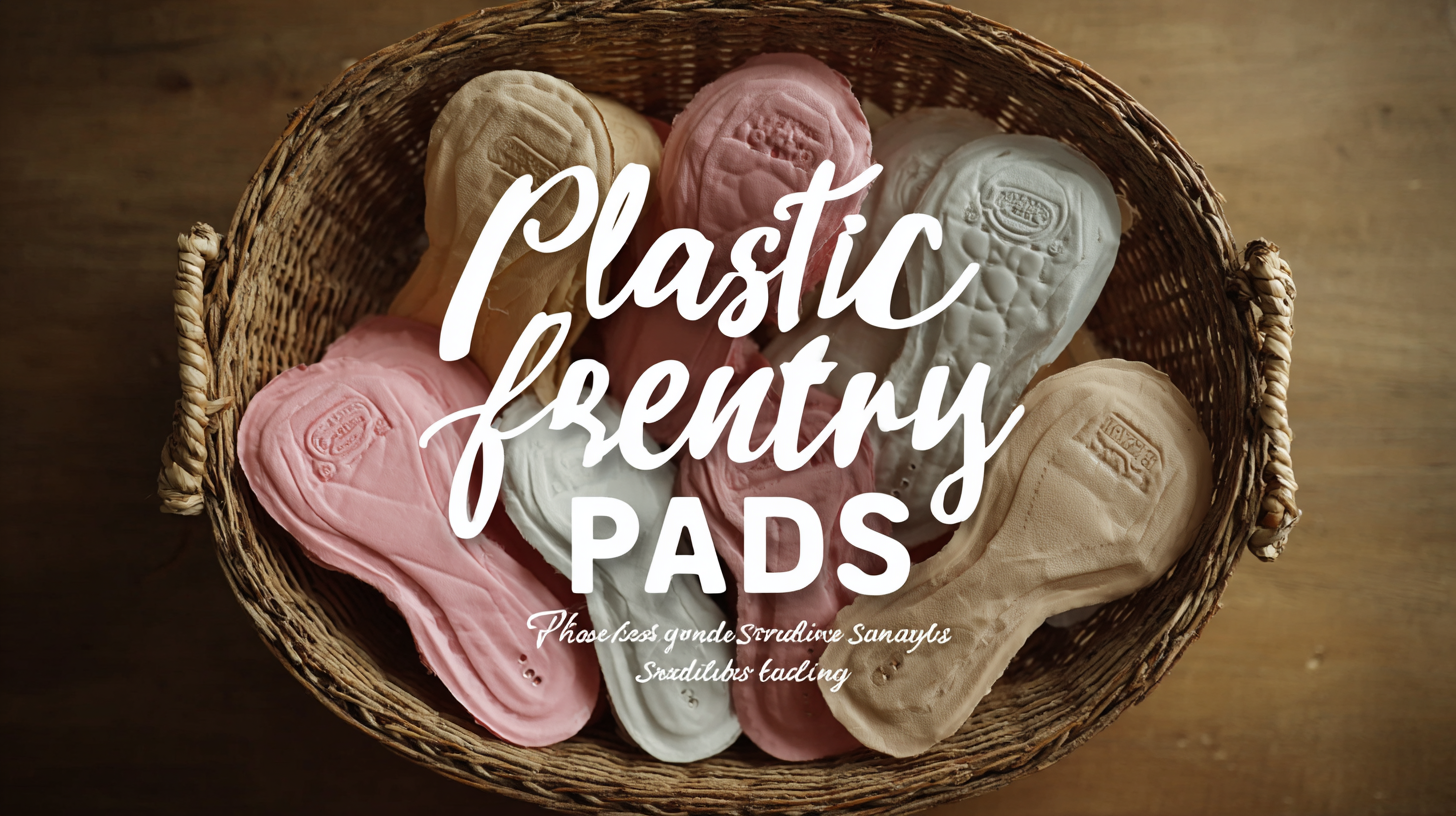
How to Choose the Best Plastic Free Sanitary Pads for Sustainable Living
In recent years, the movement towards sustainable living has gained momentum, driven by growing awareness of environmental issues and the harmful impact of single-use plastics. The global feminine hygiene market is projected to reach USD 42.49 billion by 2025, with a significant shift towards eco-friendly products.

Among these, Plastic Free Sanitary Pads have emerged as a key solution, responding to the urgent need to reduce waste generated from traditional pads, which can take hundreds of years to decompose. A study from the British Journal of Environmental Science highlights that around 200,000 tons of menstrual waste are produced annually, a significant portion being plastic-based products.
As consumers become increasingly conscious of their choices, selecting the best Plastic Free Sanitary Pads not only contributes to personal health but also promotes a sustainable future, underscoring the importance of mindful consumption in this evolving market landscape.
Understanding the Environmental Impact of Conventional Sanitary Pads
Conventional sanitary pads represent a significant environmental challenge due to their composition and disposal. Typically made from plastic and synthetic materials, these pads take hundreds of years to decompose in landfills. As they break down, they can release harmful chemicals into the soil and waterways, contributing to pollution and posing risks to both wildlife and human health. Furthermore, the production of these products often involves resource-intensive processes that contribute to greenhouse gas emissions and exacerbate climate change.
Switching to plastic-free sanitary pads can dramatically reduce this environmental footprint. These eco-friendly alternatives are usually made from organic cotton, bamboo, or other biodegradable materials that decompose much more quickly and do not leach harmful substances into the environment. By adopting these sustainable options, consumers not only minimize their ecological impact but also support brands that prioritize ethical sourcing and environmentally conscious practices. Choosing plastic-free sanitary pads is a crucial step towards a healthier planet and promotes a more circular economy in personal care products.
Key Features to Look for in Plastic Free Sanitary Pads
When choosing the best plastic-free sanitary pads for sustainable living, there are several key features to consider. Firstly, examine the materials used in the pads. Opt for products made from organic cotton, bamboo, or other biodegradable substances that ensure comfort while minimizing environmental impact. Avoid pads containing synthetic materials or chemical additives that not only harm the environment but can also irritate sensitive skin.
Another essential aspect is the absorbency and size options available. Select pads that effectively cater to your flow needs while offering various sizes for different levels of protection. Additionally, look for brands that emphasize their eco-friendly manufacturing processes, emphasizing reduced water usage and less energy consumption. Transparency regarding sourcing and production practices can significantly influence your purchasing decision. By focusing on these criteria, you can make an informed choice that aligns with your values of sustainability and health.
How to Choose the Best Plastic Free Sanitary Pads for Sustainable Living - Key Features to Look for in Plastic Free Sanitary Pads
| Feature | Description | Benefits |
|---|---|---|
| Material | Made from organic cotton, bamboo, or other natural fibers. | Chemical-free, biodegradable, and less irritating to the skin. |
| Absorbency | High absorbency rates comparable to conventional pads. | Provides leak protection and confidence during menstruation. |
| Biodegradability | Designed to decompose naturally in compost or landfills. | Reduces environmental impact and landfill waste. |
| Comfort | Soft, breathable materials that conform to the body. | Increases comfort and prevents chafing during wear. |
| Packaging | Minimal or compostable packaging materials. | Lowers plastic waste and promotes sustainability. |
| Price | Generally higher initial cost but potential long-term savings. | Encourages investment in sustainable products. |
Top Brands Leading the Charge in Sustainable Sanitary Pad Options
As consumers become more conscious of their environmental impact, the demand for sustainable sanitary products is on the rise. Top brands in the industry are responding by developing plastic-free sanitary pads that not only provide comfort and protection but also prioritize the health of our planet. Research indicates that approximately 45 billion sanitary products are disposed of each year in the U.S. alone, with a significant portion ending up in landfills. This alarming statistic underscores the importance of choosing eco-friendly options, such as biodegradable pads made from organic materials.

When considering your options, look for brands that offer transparency about their materials and production processes. Many innovative companies are now crafting pads from sustainably sourced cotton and plant-based materials, ensuring that your period care routine is both effective and environmentally responsible.
Tips:
1. Check for certifications such as OEKO-TEX or GOTS, which indicate that the products meet environmental and safety standards.
2. Explore local brands that may offer unique, sustainable solutions tailored to your region, reducing the carbon footprint associated with shipping.
3. Consider pairings with menstrual cups or period underwear, which can further minimize waste while providing reliable menstrual care.
Innovative Materials Revolutionizing Menstrual Products by 2025
 As we move toward a more sustainable future, the menstrual products we choose play a crucial role in reducing our environmental footprint. By 2025, innovative materials are set to revolutionize sanitary pads, paving the way for plastic-free options that do not compromise on comfort or effectiveness. Emerging biodegradable materials, such as organic cotton, bamboo, and hemp, are designed to break down safely, offering a guilt-free alternative to traditional plastic-filled pads.
As we move toward a more sustainable future, the menstrual products we choose play a crucial role in reducing our environmental footprint. By 2025, innovative materials are set to revolutionize sanitary pads, paving the way for plastic-free options that do not compromise on comfort or effectiveness. Emerging biodegradable materials, such as organic cotton, bamboo, and hemp, are designed to break down safely, offering a guilt-free alternative to traditional plastic-filled pads.
Tips: When selecting plastic-free sanitary pads, look for certifications like GOTS (Global Organic Textile Standard) to ensure that the materials are genuinely organic. Additionally, consider brands that prioritize transparency in their production processes, so you know exactly what you’re using. Choosing pads that are reusable, such as cloth or menstrual cups, can further enhance your sustainable living journey, minimizing waste.
As innovation continues to drive the market, keep an eye out for new products that emphasize eco-friendliness. Stay updated on companies that invest in research and development for sustainable menstruation solutions. Supporting these brands not only changes the market landscape but also empowers women to make environmentally conscious choices.
Tips for Transitioning to a Plastic Free Menstrual Routine
Transitioning to a plastic-free menstrual routine is an empowering step towards sustainable living. According to a report by the Menstrual Health Alliance, around 45 billion sanitary products are used globally every year, many containing plastic which can take hundreds of years to decompose. Embracing plastic-free sanitary pads is not just an eco-friendly choice but also a healthier option, as many conventional pads are made with synthetic fragrances and chemicals that can irritate sensitive skin.
To embark on this transition, start by exploring various eco-friendly alternatives available in the market. Look for pads made from organic cotton, bamboo, or other biodegradable materials. These options not only reduce the amount of plastic waste but are also often better for your body. A survey conducted by the Environmental Protection Agency found that using plastic-free menstrual products can significantly reduce the environmental footprint of menstruation. By opting for reusable pads or menstrual cups, users can save money in the long run while making a sizeable positive impact on the planet.
Remember that change takes time, and making small adjustments can lead to significant benefits. Just as one might switch out plastic shower products for solid alternatives, introducing plastic-free sanitary products can be a seamless part of your eco-conscious lifestyle. Start by incorporating one new product each month, and you’ll soon find a routine that aligns with your values while taking care of your health and the environment.



